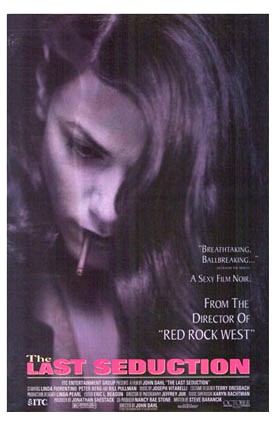Written by Rachael Johnson as part of our theme week on Representations of Female Sexual Desire.
Bridget Gregory is one of American cinema’s great anti-heroines. Flawlessly played by Linda Fiorentino, she is the amoral yet captivating protagonist of John Dahl’s 1994 thriller, The Last Seduction. Fiorentino’s Bridget is a lithe, beautiful woman, and her look evokes heroines of post-war noir. Her sleek, dark hair has a Golden Age cut and style, and a cigarette is never far from her perfect lips. But Dahl’s neo-noir offers an original, post-modern female villain. She’s a femme fatale for the 90s. Bridget is, at heart, a tough, lone wolf entirely dedicated to serving her own interests and ensuring her self-preservation. A female lone wolf is rare in American movies and one of the pleasures of The Last Seduction is watching her survive and thrive. Bridget is, also, gender-subversive as well as a desiring and assertive erotic subject. It is her sexual subjectivity that enthralls, amuses, and entertains.
Made crystal clear from the very start of the film, Bridget is a colorful piece of work. She’s the manager of a New York telemarketing company, and we first see her taunting and egging on her subordinates with inspirational insults such as “maggots,” “suckers,” “bastards,” and “eunuchs.” Dahl cuts between this scene and another involving a man meeting two younger guys under a bridge. The man, we will discover shortly, is Bridget’s husband, Clay Gregory (Bill Pullman). A medical resident desperately in need of cash, he is presently selling drugs to pay off a loan shark. The dangerous, nerve-wracking deal scores the couple a handsome sum.
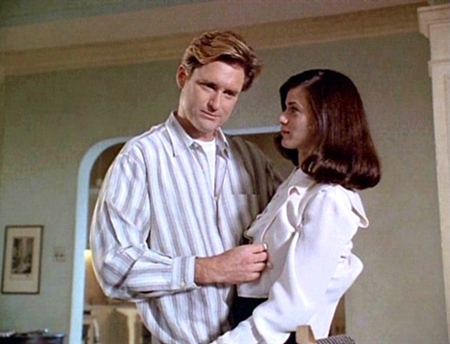
Clay is also a piece of work. As acquisitive as Bridget, he is also capable of violence. When Bridget later calls Clay an “idiot” back in their apartment for carrying the money around in broad daylight, he strikes her. He makes the cowardly excuse that he was shaken up by the deal, and Bridget fakes forgiveness. When he’s in the shower, however, she runs off with the stash. Before she quits the city, Bridget takes off her wedding ring. The act signifies a rejection of domesticity and traditional coupling as well as a repudiation of age-old ideas of female subservience and sacrifice. It also signals that she will now drive the narrative. Although the act of abuse serves as a trigger, the viewer is, in fact, encouraged to believe that Bridget is motivated by more than vengeance. She wants total mastery of her destiny and will do anything to achieve it.
She flees north. Stopping in a small, characterless town in “cow country,” she drops into a run-of-the-mill bar. A gorgeous, svelte yet foul-mouthed New Yorker, Bridget is perceived as an exotic figure in these parts. A young, attractive man with a pleasant personality and the very ordinary name of Mike, is drawn to her. Mike (Peter Berg) buys her a drink when her ungracious demand for a Manhattan is, quite understandably, ignored by the bartender.
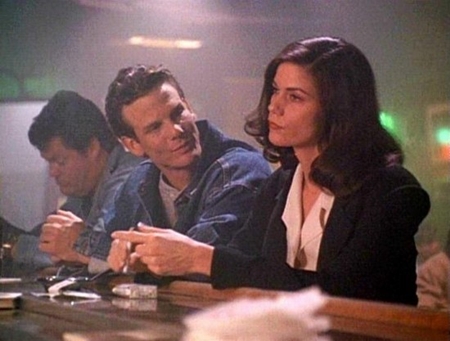
Their first encounter serves as an amusing, outrageous antidote to the saccharine meet-cutes of 90s romantic comedies. Bridget initially refuses Mike’s quite ordinary advances in inimitably impolite fashion: “Go find yourself a nice little cowgirl and make nice little cow babies and leave me alone.” But when Mike good-humoredly makes the claim that he’s “hung like a horse,” Bridget offers him a seat. She proceeds to unzip his pants, fondle his dick, probe him about his sexual history, and, then, smell her fingers. Inspection over, the newly acquainted couple head off to his place and spend the night together. The morning after, she heads off without telling him her name or saying goodbye.
Their next meeting, at Mike’s place of work, is pure coincidence. Deciding to lay low in the town, Bridget secures a managerial position at the same insurance company as her new lover, and takes on the name of Wendy Kroy. She wants distance from Mike at work and warns him: “Don’t fuck with my image.” She is, however, more sociable when she meets him again at the bar.
They soon have sex near the dumpster behind the bar. Bridget directs their love-making and plays the more sexually dynamic part. Hanging onto the rails, in an elevated position, Bridget fucks Mike against a fence. With his pants down to his ankles and knees bent, he looks the more vulnerable partner in this al fresco erotic episode. He is also the emotionally vulnerable lover. “Where do I fit in?” Mike asks Bridget. “You’re my designated fuck,” she replies. She later rides him in her car.

Bridget, for the most part, assumes the traditionally dominant position in her love-making sessions with Mike. The filmmakers’ characterization of their female protagonist’s desire is unusual for American cinema. Bridget’s physical beauty is certainly not obscured, but she cannot be characterized as a classic Hollywood sex object. She is, instead, presented as an assertive, dynamic sexual subject. Intense physical pleasure is not bound up with the self-abandonment of romantic love. Nor does it signify psychic self-annihilation. Reproduction, furthermore, does not play a part in Bridget’s world. She and her husband are childless. Love has an ideological import, and it has often, let’s face it, been a trap for women in patriarchal society. Bridget, however, is not confined by love. Sex, for her, is about control, pleasure and play.
Mike, however, falls in love with Bridget and craves a more emotionally intimate relationship. He is flattered that she has chosen him, as he believes himself to be “bigger than this town.” Although he bemoans, in a somewhat boyish way, her arrogance and dominance. Mike realizes, a little late, that Bridget is a dangerous, amoral woman. He calls her “sick” and “deranged” when she suggests they “sell murder” to people (for example, to women who have been betrayed by their husbands), but he is ultimately ignorant of her true intentions. She becomes increasingly calculating with her lover, and he just can’t keep up. Although Mike is horrified when Bridget (falsely) tells him that she has successfully sold murder, he is eventually manipulated into agreeing to kill Clay. Note that Bridget has lied to him about the identity of his target. Mike is unaware that he has been sent to New York to murder Bridget’s husband; he believes his target to be a man who’s been driving old ladies out of their homes. I will not tell you what happens when Mike encounters Clay.
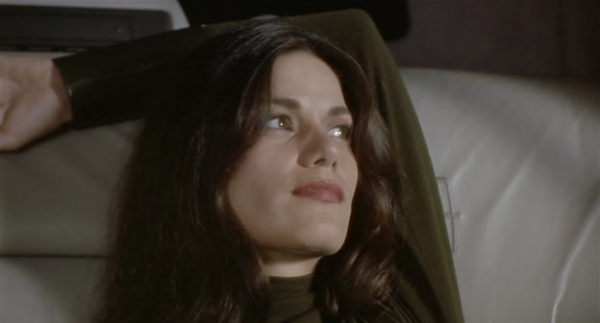
Bridget’s treatment of people, particularly men, remains consistently appalling throughout the film, but it goes beyond crude invective and exploitation. Bridget admits to Mike that she enjoys “bending the rules, playing with people’s brains.” She exploits both society’s moral codes and prejudices and takes advantage of the kindness of others. She espouses a certain moral relativism. When Mike says, helplessly, “Murder is wrong,” Bridget counters, “Unless the President says to do it.” In fact, Bridget gains an almost sexual pleasure plotting her clever moves. She screws men both literally and metaphorically.
Bridget’s unbound sexuality and gender-subversive behavior make her evil more interesting and radical. She knows how to manipulate the gender order and succeed in a phallocentric world. She is unfailingly resourceful and supernaturally resilient. In a way, this amoral female protagonist functions to strip patriarchy bare. Her cynical, manipulative words and acts serve to expose the weaknesses and wickedness of men: their insecurities, secrets, and vulnerabilities as well as their aggressive, acquisitive traits.
Bridget, as we have seen, does not conform to culturally constructed norms of femininity. She also manipulates and mocks conventional expectations of gender. Her parodic skills are neatly demonstrated in one short, entertaining scene when she offers cookies to a local detective her husband has recruited. Wearing a lace apron and a smile, she delivers the sweet gift to the man watching her movements in his parked car. He does not, however, see her placing a plank of nails by his tires, and he has only himself to blame when she drives off to an unknown destination.
The Last Seduction does not, of course, endorse a reversal of domination, but the movie makes for a playfully, and knowingly, subversive viewing experience. Although Bridget’s actions should not be read in a literal, man-hating way, female viewers may derive psychological pleasure from watching Bridget’s erotic, self-interested shenanigans. It’s exhilarating to see a female cinematic character take sexual control and outwit her male partners. It makes a refreshing change from watching women suffer the pain of romantic love. We know that Bridget will never be a victim. She will never tolerate domestic drudgery or the compromises marriage brings. In fact, it’s pretty much a given that she will always overcome her opponents. Life is a pitiless yet entertaining Darwinian game in The Last Seduction, and Bridget plays it brilliantly.
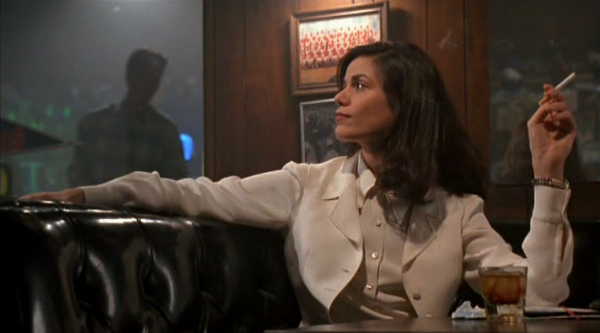
Fiorentino’s interpretation of our deeply sexy, whip-smart anti-heroine is supremely persuasive. The casting is perfect; the actress should have won an Oscar for her performance, but the movie was shut out of the nominations because it was first shown on cable television before being given a cinematic release. Rules may be rules, but it’s nothing less than a sin that both Fiorentino and John Dahl’s smart, stylish film were deemed ineligible.
The Last Seduction is elegantly shot, well-paced and cleverly constructed. Bridget is the dominant sexual and narrative subject. The story is primarily shaped by her sensual, self-interested needs. If she can be characterized as a feminist cultural icon, she’s an amusing, distinctly anti-humanist one. One thing that’s certain is that watching her at work and play is the cinematic equivalent of an empowering Manhattan cocktail.
